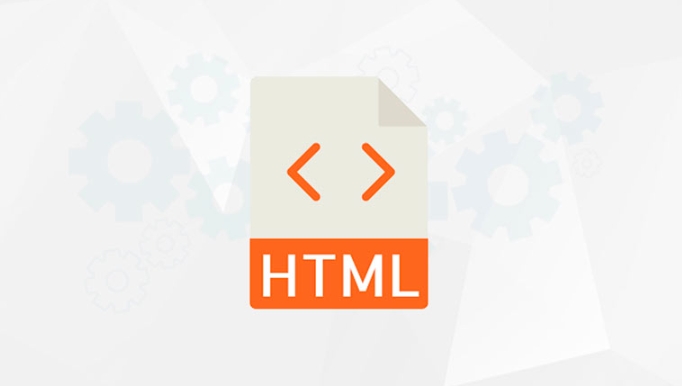Use the

Not necessary, but using the <nav></nav> tag is indeed more standardized.
 tag?" />
tag?" /> HTML5 introduces semantic tags, such as <nav></nav> , <header></header> , footer> , etc., to make your page structure clearer. Among them, the purpose of <nav></nav> is to wrap the main navigation links, such as the main navigation bar at the top of the website, the menu in the sidebar, the link group in the footer, etc.
However, not all links have to be put into <nav></nav> . If it is just a single jump link in the page or some embedded links in the article, there is no need to set up a <nav></nav> . It is better to use it, and there will be no errors if you don’t use it, but for the sake of readability and accessibility, it is recommended to use it in the right place.
 tag?" />
tag?" /> When should I use <nav></nav> ?
- Main navigation area : The main navigation bar at the top or side of the web page, usually including links such as "Home", "About Us", "Product", "Contact".
- Auxiliary navigation : such as quick links in the footer, related page jumps, paging navigation, etc.
- Multi-link collection : When you have a set of links that are all together for navigation purposes, you can consider using
<nav></nav>.
<nav>
<ul>
<li><a href="/">Home</a></li>
<li><a href="/about">About Us</a></li>
<li><a href="/contact">Contact us</a></li>
</ul>
</nav>The benefits of writing this way are:
- Screen readers can recognize this as a navigation area to improve barrier-free experience;
- The page structure is clearer, making it easier to maintain and style control;
- It also helps SEO (although it has little impact).
When can I not use <nav></nav> ?
Not all links require <nav></nav> , and the following situations can be omitted:
 tag?" />
tag?" />- Individual links on the page, such as the guided link "Click to learn more";
- Submit button or other action link in the form;
- Hyperlinks inserted in the article content, such as citation sources;
- Collection of links for non-navigation purposes, such as social icons, tool-like links, etc.
In these cases, just use the <a></a> tag directly, and there is no need to deliberately add <nav></nav> . Semantics are for better structure, rather than forcing every link to be wrapped.
Some suggestions in actual development
- Don't abuse
<nav></nav>: A page usually only needs one or two<nav></nav>areas, and too many will interfere with the experience of screen reader users. - It is better to use in combination with ARIA : for example, adding
aria-labeloraria-labelledbyto<nav></nav>can help assistive technology users better understand the purpose of navigation. - Style does not affect the structure : you can layout the style without using
<nav></nav>, but keep the semantics clear in the HTML structure, and CSS can freely control the appearance.
Basically that's it. Rational use of <nav></nav> is a good coding habit, especially in teamwork or long-term maintenance projects, but it is not a hard and strict regulation. The key is to look at the specific scenario.
The above is the detailed content of Should navigation links always be in a tag?. For more information, please follow other related articles on the PHP Chinese website!

Hot AI Tools

Undress AI Tool
Undress images for free

Undresser.AI Undress
AI-powered app for creating realistic nude photos

AI Clothes Remover
Online AI tool for removing clothes from photos.

Clothoff.io
AI clothes remover

Video Face Swap
Swap faces in any video effortlessly with our completely free AI face swap tool!

Hot Article

Hot Tools

Notepad++7.3.1
Easy-to-use and free code editor

SublimeText3 Chinese version
Chinese version, very easy to use

Zend Studio 13.0.1
Powerful PHP integrated development environment

Dreamweaver CS6
Visual web development tools

SublimeText3 Mac version
God-level code editing software (SublimeText3)
 VSCode settings.json location
Aug 01, 2025 am 06:12 AM
VSCode settings.json location
Aug 01, 2025 am 06:12 AM
The settings.json file is located in the user-level or workspace-level path and is used to customize VSCode settings. 1. User-level path: Windows is C:\Users\\AppData\Roaming\Code\User\settings.json, macOS is /Users//Library/ApplicationSupport/Code/User/settings.json, Linux is /home//.config/Code/User/settings.json; 2. Workspace-level path: .vscode/settings in the project root directory
 How to handle transactions in Java with JDBC?
Aug 02, 2025 pm 12:29 PM
How to handle transactions in Java with JDBC?
Aug 02, 2025 pm 12:29 PM
To correctly handle JDBC transactions, you must first turn off the automatic commit mode, then perform multiple operations, and finally commit or rollback according to the results; 1. Call conn.setAutoCommit(false) to start the transaction; 2. Execute multiple SQL operations, such as INSERT and UPDATE; 3. Call conn.commit() if all operations are successful, and call conn.rollback() if an exception occurs to ensure data consistency; at the same time, try-with-resources should be used to manage resources, properly handle exceptions and close connections to avoid connection leakage; in addition, it is recommended to use connection pools and set save points to achieve partial rollback, and keep transactions as short as possible to improve performance.
 Mastering Dependency Injection in Java with Spring and Guice
Aug 01, 2025 am 05:53 AM
Mastering Dependency Injection in Java with Spring and Guice
Aug 01, 2025 am 05:53 AM
DependencyInjection(DI)isadesignpatternwhereobjectsreceivedependenciesexternally,promotingloosecouplingandeasiertestingthroughconstructor,setter,orfieldinjection.2.SpringFrameworkusesannotationslike@Component,@Service,and@AutowiredwithJava-basedconfi
 python itertools combinations example
Jul 31, 2025 am 09:53 AM
python itertools combinations example
Jul 31, 2025 am 09:53 AM
itertools.combinations is used to generate all non-repetitive combinations (order irrelevant) that selects a specified number of elements from the iterable object. Its usage includes: 1. Select 2 element combinations from the list, such as ('A','B'), ('A','C'), etc., to avoid repeated order; 2. Take 3 character combinations of strings, such as "abc" and "abd", which are suitable for subsequence generation; 3. Find the combinations where the sum of two numbers is equal to the target value, such as 1 5=6, simplify the double loop logic; the difference between combinations and arrangement lies in whether the order is important, combinations regard AB and BA as the same, while permutations are regarded as different;
 Understanding the Java Virtual Machine (JVM) Internals
Aug 01, 2025 am 06:31 AM
Understanding the Java Virtual Machine (JVM) Internals
Aug 01, 2025 am 06:31 AM
TheJVMenablesJava’s"writeonce,runanywhere"capabilitybyexecutingbytecodethroughfourmaincomponents:1.TheClassLoaderSubsystemloads,links,andinitializes.classfilesusingbootstrap,extension,andapplicationclassloaders,ensuringsecureandlazyclassloa
 How to work with Calendar in Java?
Aug 02, 2025 am 02:38 AM
How to work with Calendar in Java?
Aug 02, 2025 am 02:38 AM
Use classes in the java.time package to replace the old Date and Calendar classes; 2. Get the current date and time through LocalDate, LocalDateTime and LocalTime; 3. Create a specific date and time using the of() method; 4. Use the plus/minus method to immutably increase and decrease the time; 5. Use ZonedDateTime and ZoneId to process the time zone; 6. Format and parse date strings through DateTimeFormatter; 7. Use Instant to be compatible with the old date types when necessary; date processing in modern Java should give priority to using java.timeAPI, which provides clear, immutable and linear
 Using PHP for Data Scraping and Web Automation
Aug 01, 2025 am 07:45 AM
Using PHP for Data Scraping and Web Automation
Aug 01, 2025 am 07:45 AM
UseGuzzleforrobustHTTPrequestswithheadersandtimeouts.2.ParseHTMLefficientlywithSymfonyDomCrawlerusingCSSselectors.3.HandleJavaScript-heavysitesbyintegratingPuppeteerviaPHPexec()torenderpages.4.Respectrobots.txt,adddelays,rotateuseragents,anduseproxie
 Google Chrome cannot open local files
Aug 01, 2025 am 05:24 AM
Google Chrome cannot open local files
Aug 01, 2025 am 05:24 AM
ChromecanopenlocalfileslikeHTMLandPDFsbyusing"Openfile"ordraggingthemintothebrowser;ensuretheaddressstartswithfile:///;2.SecurityrestrictionsblockAJAX,localStorage,andcross-folderaccessonfile://;usealocalserverlikepython-mhttp.server8000tor






